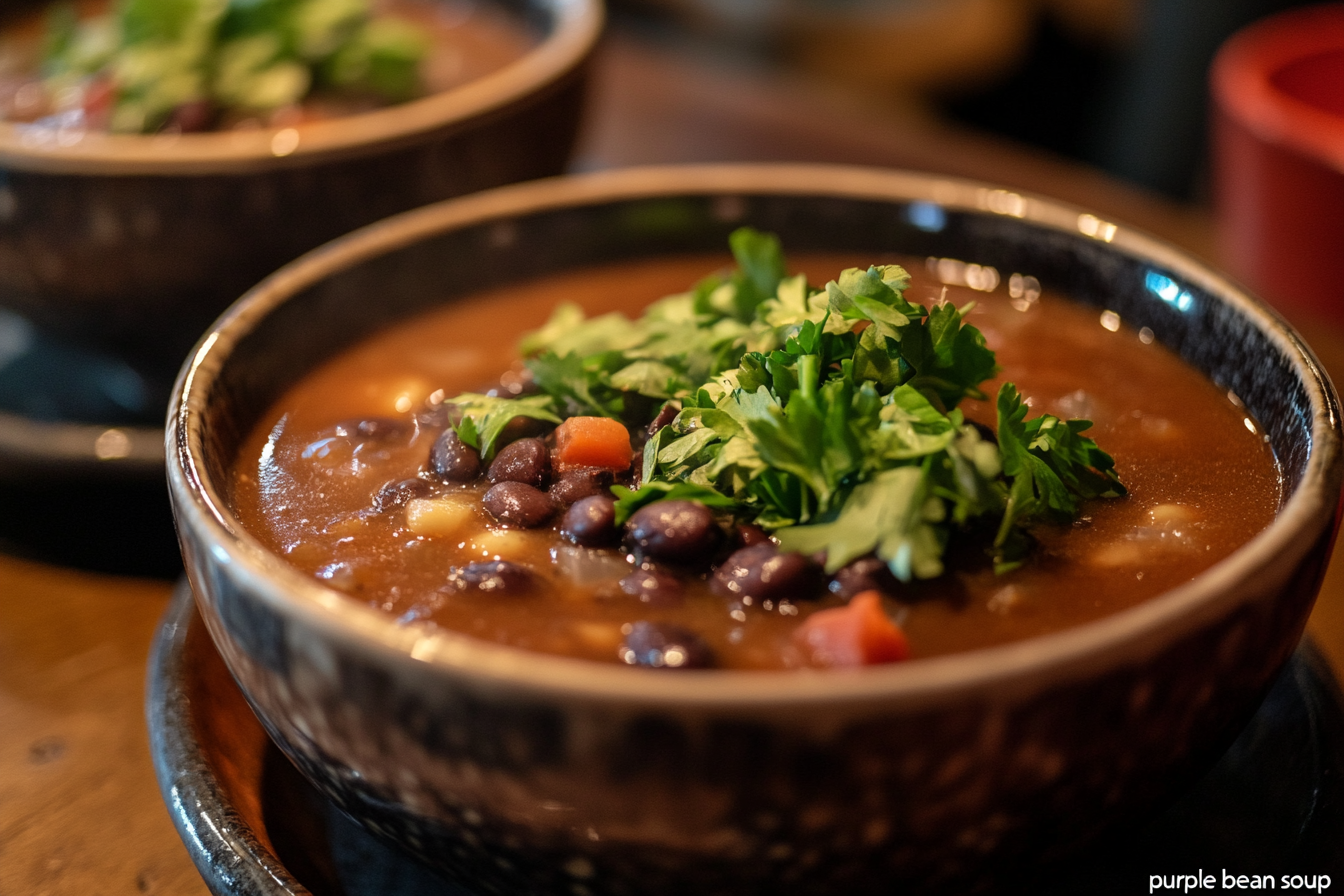Black bean soup is not just a comforting dish—it’s a nutritional powerhouse. With its rich flavor, versatility, and numerous health benefits, this soup fits seamlessly into various diets and lifestyles. In this guide, we will explore why black bean soup is good for you, delving into its nutritional profile, health advantages, and ways to customize it for maximum wellness.
Understanding the Nutritional Profile of Black Beans
Black beans, the star ingredient of this soup, are often considered a superfood due to their dense nutritional content. Not only are they rich in protein, but they also provide essential vitamins and minerals that contribute to overall health.
High in Protein: A Plant-Based Powerhouse
To begin with, black beans are an excellent source of plant-based protein, which is crucial for muscle repair and energy. For instance, one cup of cooked black beans contains about 15 grams of protein, making it ideal for vegetarians and vegans. Furthermore, this protein can easily complement other nutrients in your diet.
Rich in Fiber: Promoting Digestive Health
In addition to protein, black beans are packed with fiber, boasting approximately 15 grams per cup. This fiber is vital for maintaining digestive health, as it promotes regularity and prevents constipation. Moreover, it keeps you feeling full longer, making it a great option for weight management.
Packed with Vitamins and Minerals
On top of protein and fiber, black beans provide a wealth of essential vitamins and minerals, such as:
- Iron, which supports oxygen transport in the blood.
- Magnesium, vital for energy production and muscle function.
- Folate, crucial for DNA formation and cell growth, especially during pregnancy.
By incorporating black beans into your diet, you can enjoy these health benefits without needing expensive supplements.
Nutritional Additions from Soup Ingredients
While black beans are the main component of the soup, the other ingredients also contribute significantly to its health benefits. This combination makes black bean soup not just nutritious but also incredibly well-rounded.
Vegetables: Carrots, Onions, Garlic, and Their Benefits
For instance, vegetables like carrots, onions, and garlic add not only flavor but also essential nutrients:
- Carrots provide beta-carotene, which is converted to Vitamin A for improved vision and immune health.
- Onions and Garlic contain compounds like allicin, which have anti-inflammatory and immune-boosting properties.
Moreover, these vegetables make the soup more filling while keeping the calorie count low.
Healthy Fats from Olive Oil or Avocado
Healthy fats further enhance the nutritional value of black bean soup. For example:
- Olive Oil adds monounsaturated fats that support heart health and reduce bad cholesterol.
- Avocado, often used as a topping, provides a creamy texture along with additional fiber and potassium.
These fats not only improve flavor but also help your body absorb fat-soluble vitamins more effectively.
Bone Broth or Vegetable Broth
Using broth as the soup’s base introduces additional nutrients. For instance:
- Bone Broth supplies collagen, which supports joint and skin health.
- Vegetable Broth is a vegan alternative that adds vitamins and minerals while keeping the soup light.
By choosing the right broth, you can customize the soup to align with your dietary preferences.
Top Health Benefits of Black Bean Soup
Now that we’ve covered the ingredients, let’s examine the specific health benefits of black bean soup. When prepared thoughtfully, this dish becomes a nutritional powerhouse that supports various aspects of health.
Supporting Heart Health
First and foremost, black bean soup promotes heart health through its fiber, potassium, and antioxidant content.
How Fiber Reduces Cholesterol Levels
For instance, soluble fiber in black beans binds to cholesterol in the digestive tract, preventing its absorption. Consequently, this can lead to lower LDL (bad cholesterol) levels, thereby reducing the risk of heart disease.
The Role of Potassium in Lowering Blood Pressure
In addition to fiber, the potassium in black beans helps balance sodium levels in the body, which can reduce high blood pressure. This balance is especially beneficial for those looking to manage hypertension.
Aiding Digestive Health
Furthermore, black bean soup supports digestive health, making it a great choice for those with gut-related concerns.
High Fiber Content for Improved Regularity
For instance, the high fiber content promotes healthy bowel movements by adding bulk to the stool. Additionally, it helps prevent issues like constipation and bloating.
Prebiotic Benefits: Feeding Gut Microbiota
Moreover, black beans act as prebiotics, meaning they feed beneficial bacteria in the gut. This improves overall gut health and may even boost immunity over time.
Stabilizing Blood Sugar Levels
Black bean soup is also an excellent option for individuals with diabetes or those looking to manage blood sugar levels.
Low Glycemic Index: Good for Diabetics
For example, black beans have a low glycemic index, meaning they release glucose slowly into the bloodstream. As a result, this prevents sharp spikes and crashes in blood sugar.
Slowing Glucose Absorption with Soluble Fiber
Furthermore, the soluble fiber in black beans slows down the absorption of glucose in the digestive system. This makes black bean soup an excellent meal choice for maintaining stable energy levels throughout the day.
Providing Antioxidants and Anti-Inflammatory Benefits
Finally, black bean soup is rich in antioxidants and anti-inflammatory compounds, which support overall health and reduce the risk of chronic diseases.
Anthocyanins in Black Beans: Fighting Free Radicals
Anthocyanins, the compounds responsible for the dark color of black beans, are powerful antioxidants. For example, they neutralize free radicals in the body, reducing oxidative stress and lowering the risk of certain cancers.
Garlic, Onion, and Spices as Natural Anti-Inflammatory Agents
Additionally, ingredients like garlic, onions, and spices such as cumin and turmeric contribute anti-inflammatory benefits. Consequently, these ingredients can help reduce inflammation and promote overall wellness.
How to Make Black Bean Soup Healthier
While black bean soup is already nutritious, there are several ways to enhance its health benefits further.
Lowering Sodium in Homemade or Store-Bought Soups
For instance, excess sodium can be a concern in soups. To counteract this, consider:
- Using low-sodium broth or water as a base.
- Avoiding processed seasonings and instead using fresh herbs and spices.
By taking these steps, you can keep your soup flavorful without compromising on health.
Adding Nutrient-Dense Ingredients
To boost nutrition even more, try adding:
- Leafy Greens: Spinach or kale for added vitamins and minerals.
- Protein Boosters: Ingredients like quinoa, tofu, or chicken for extra protein.
These additions not only make the soup more filling but also cater to specific dietary needs.
1. Enhancing Flavor with Layered Cooking
To create a more flavorful soup, layer your ingredients thoughtfully:
- Start with Aromatics: Sauté onions, garlic, and celery in olive oil or butter to create a flavorful base. Adding a pinch of salt at this stage draws out the natural sweetness of the vegetables.
- Bloom Spices: Add spices like cumin, smoked paprika, or chili powder to the hot oil before adding liquids. This releases their essential oils and deepens their flavor.
- Add Fresh Herbs at the End: Stir in cilantro, parsley, or thyme just before serving for a burst of freshness.
2. Customizing the Texture
The texture of black bean soup can make or break the dish. Here’s how to tailor it to your liking:
- For a Creamy Soup: Use an immersion blender to puree half of the soup while leaving the other half chunky. This creates a creamy texture without adding dairy.
- For a Brothier Soup: Add more liquid (broth or water) and reduce the amount of blended beans. Adjust seasonings to balance the flavor.
- For a Thicker Soup: Mash some of the beans with a potato masher or puree a larger portion of the soup. Stirring in a bit of cornstarch or arrowroot slurry can also thicken the soup.
3. Maximizing Nutritional Value
Black bean soup is already nutrient-dense, but you can supercharge it with these additions:
- Leafy Greens: Stir in chopped spinach, kale, or Swiss chard during the last 5 minutes of cooking for extra vitamins and minerals.
- Whole Grains: Add cooked quinoa, farro, or brown rice to boost fiber and make the soup more filling.
- Healthy Fats: Drizzle with olive oil or add a sliced avocado to increase satiety and heart-healthy fats.
4. Balancing Flavors
Balance is key to a delicious soup. If your soup feels “off,” try these adjustments:
- Too Salty: Add a splash of vinegar (apple cider or white) or a squeeze of lemon juice to cut through the saltiness.
- Too Bland: Boost with a pinch of salt, a dash of hot sauce, or a sprinkle of smoked paprika.
- Too Thick: Thin it out with additional broth or water, then adjust seasonings as needed.
- Too Watery: Simmer uncovered to let excess liquid evaporate, concentrating the flavors.
5. Incorporating Unique Add-Ins
For a creative twist, try adding one or more of the following:
- Roasted Vegetables: Add diced roasted sweet potatoes, zucchini, or bell peppers for a smoky and caramelized flavor.
- Sweet and Tangy Elements: Stir in a splash of balsamic vinegar or a touch of honey to balance the earthy flavor of black beans.
- Savory Enhancers: Add a dollop of miso paste or a tablespoon of soy sauce for a depth of umami.
6. Serving Suggestions
Elevate your soup with thoughtful pairings and garnishes:
- Toppings: Garnish with diced avocado, tortilla strips, sour cream, or shredded cheese for added texture and flavor.
- Side Dishes: Serve with cornbread, warm tortillas, or a side salad featuring citrus and avocado.
- Breakfast Twist: Top leftover soup with a poached egg and a sprinkle of cotija cheese for a hearty morning meal.
7. Reducing Cooking Time
If you’re short on time, you can still create a delicious black bean soup:
- Use Canned Beans: Opt for low-sodium canned black beans to skip soaking and long cooking times. Rinse them thoroughly to reduce sodium content.
- Pressure Cooker: Use an Instant Pot or pressure cooker to cook dried beans and soup in under an hour.
- Quick-Soak Method: Boil dried beans for 1–2 minutes, then let them sit in hot water for 1 hour before draining and using.
8. Tailoring for Specific Dietary Needs
Customize your soup to fit your dietary preferences:
- Vegan or Vegetarian: Use vegetable broth and skip any animal-based toppings like cheese or sour cream. Nutritional yeast can be used for a cheesy flavor.
- Gluten-Free: Ensure all ingredients, including broth and spices, are certified gluten-free.
- Low-Carb: Limit starchy add-ins like corn or rice and load up on protein and greens instead.
- High-Protein: Add shredded chicken, turkey, or plant-based options like tempeh or tofu to increase the protein content.
9. Storage and Reheating Tips
Keep your soup fresh and flavorful with proper storage:
- Refrigerate: Store leftovers in an airtight container in the fridge for up to 5 days.
- Freeze: Divide soup into individual portions and freeze for up to 3 months. Label each container with the date for easy tracking.
- Reheat: Gently reheat soup on the stovetop over low heat, stirring occasionally. Add a splash of water or broth to restore its original consistency.
10. Common Mistakes and How to Avoid Them
Avoid these common pitfalls to ensure a perfect bowl of black bean soup every time:
- Over-Salting: Add salt gradually and taste frequently, especially if using canned beans or pre-seasoned broth.
- Mushy Vegetables: Add tender vegetables like zucchini or spinach near the end of cooking to maintain their texture.
- Under-Cooked Beans: If using dried beans, ensure they’re fully cooked before blending or serving to avoid a grainy texture.

